Guzmania Bromeliad: Care Tips For This Jazzy Blooming Plant
These tropical beauties are popular because of their large, vibrant blooms. What makes guzmanias truly special is their remarkable variety of flower colors, setting them apart from other bromeliad species. This guide on Guzmania bromeliad care will keep yours looking tip-top.
When I worked in the interior landscaping trade, we used these in mass plantings in malls, building lobbies, and hotels because people loved their showy, eye-catching colors. This bromeliad is easy to find, and you may even be able to pick one up at your supermarket alongside the other houseplants and cut flowers.
Note: There are many guzmania bromeliads on the market. Now species and varieties are grown in a wide range of colors like orange, yellow, pink, plum, white, and even combos of the colors. Guzmania lingulata, which has a red flower, is commonly sold. You may also be able to find Guzmania Candy, Guzmania Hope, Guzmania conifera, and Guzmania Mathilda.
Regardless of which one you have, the care is the same!
Guzmania Bromeliad Care Guide
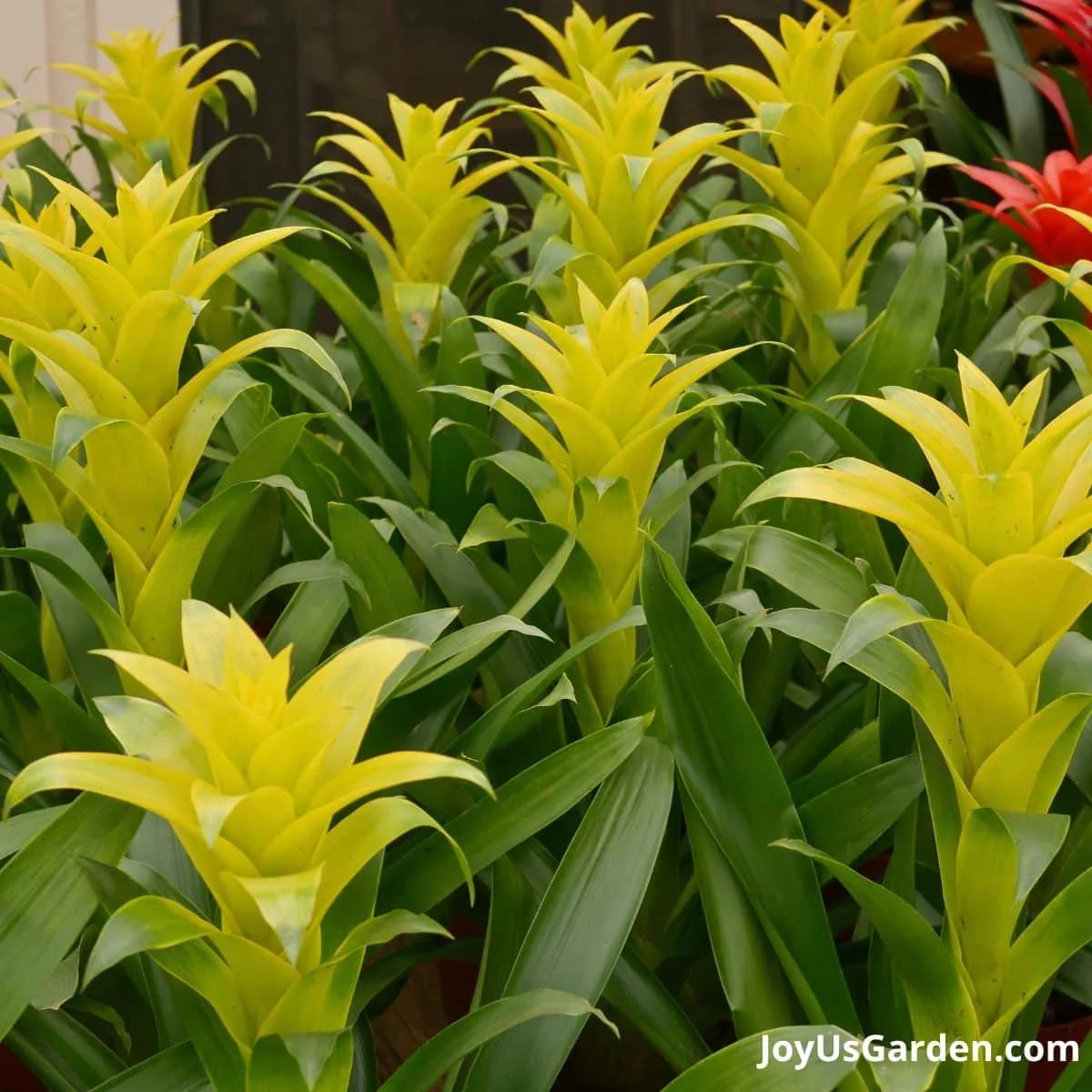
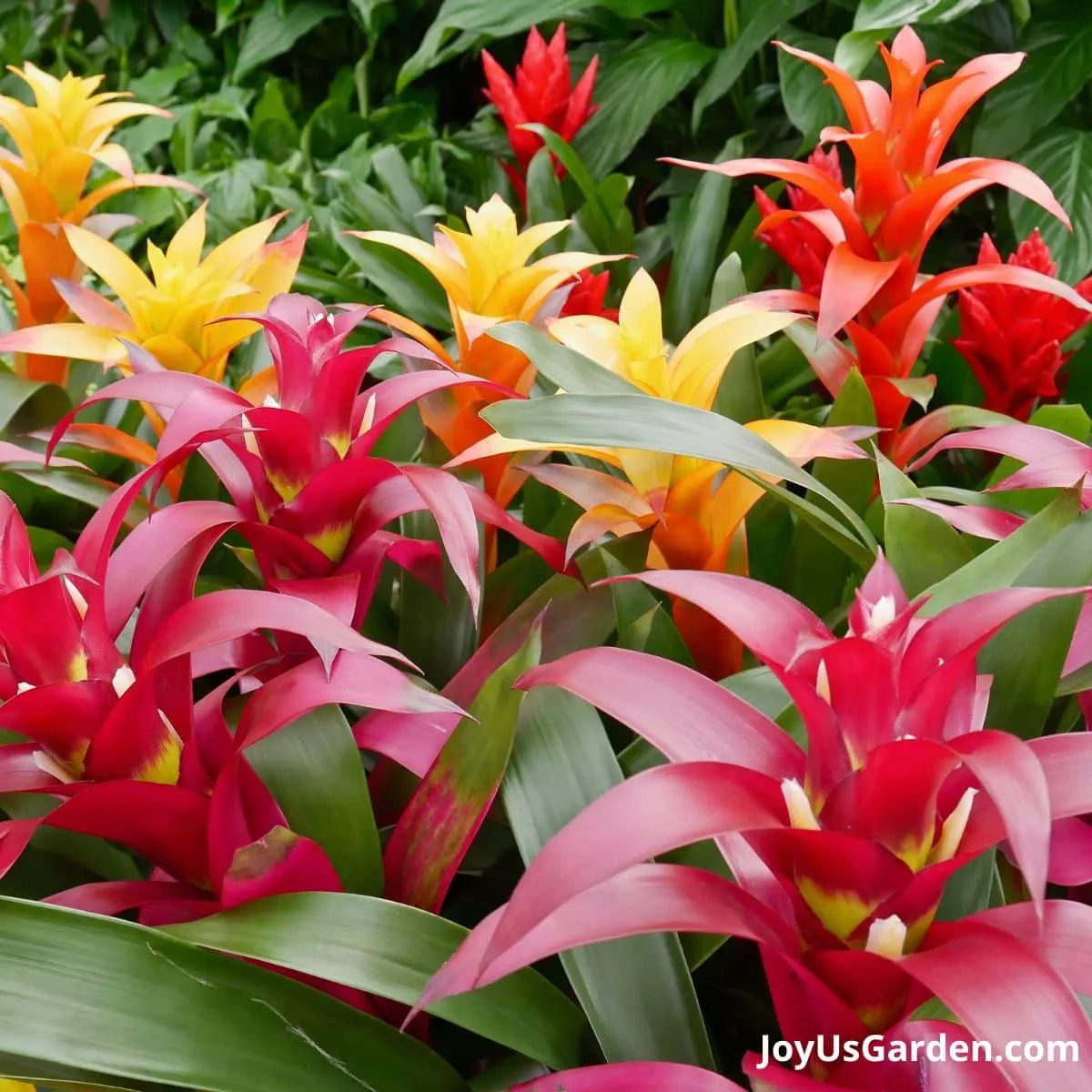
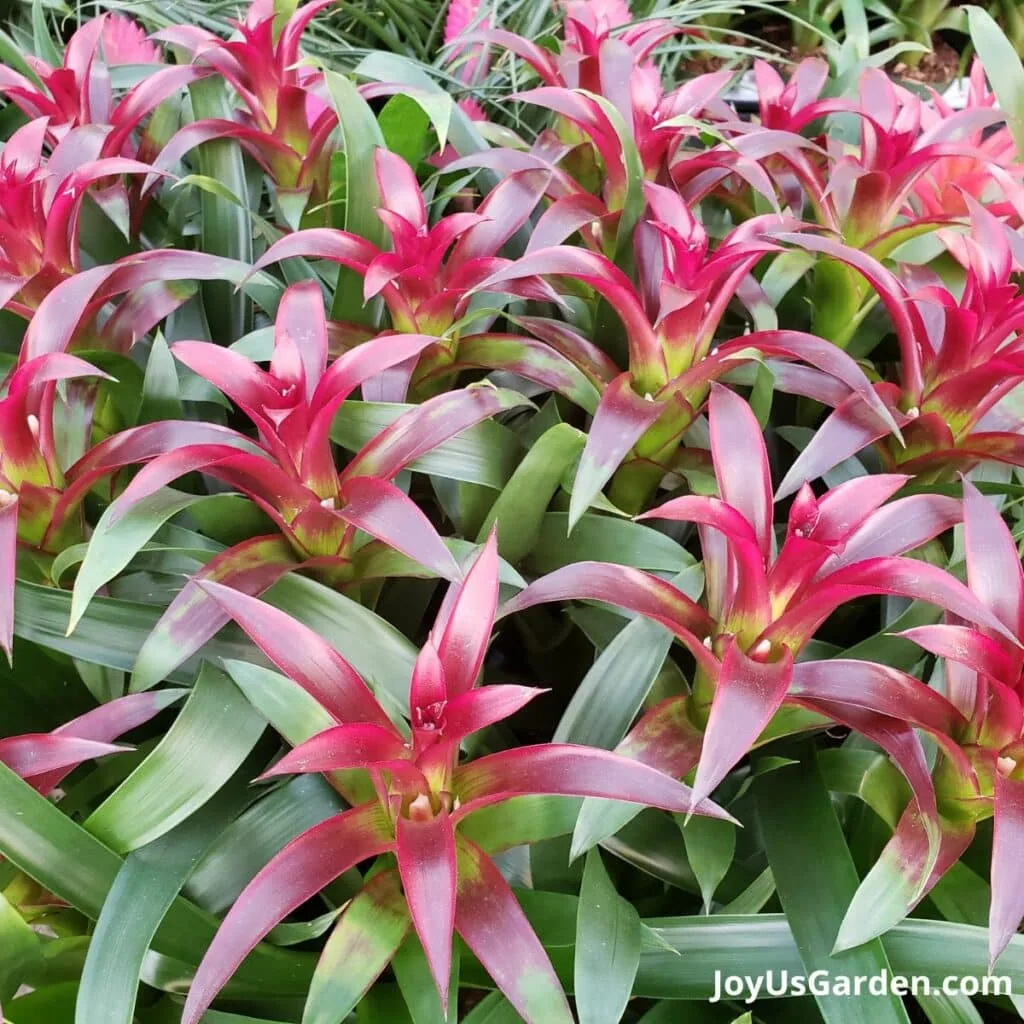
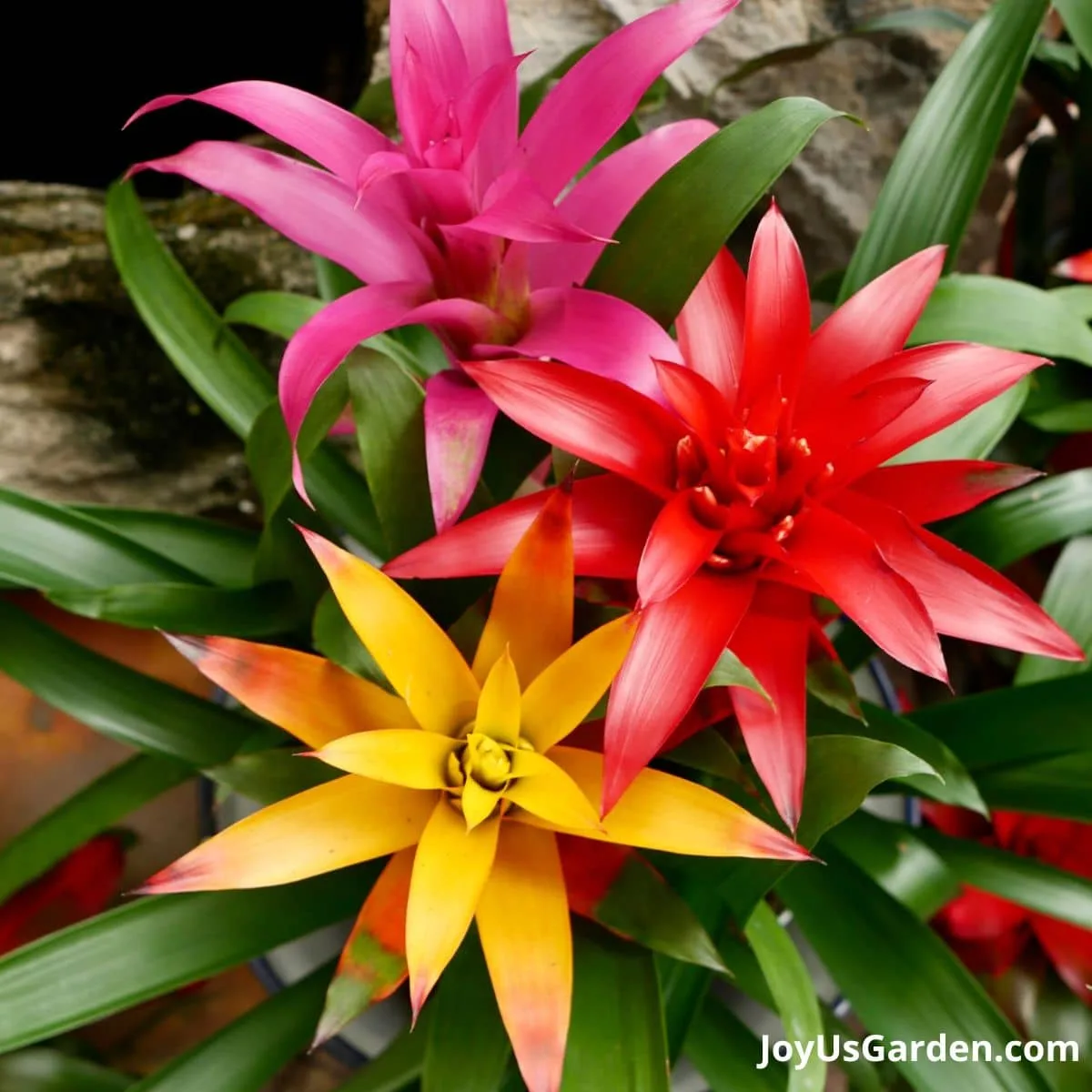
Guzmania Light Requirements
Guzmanias prefer and are happiest in bright, natural light like other bromeliads. In their natural environment, they grow under the canopies of other plants on the forest floor, where it’s bright, but the direct sun is filtered through.
An east or west exposure would be best, but keep them out of hot windows to avoid prolonged exposure to direct sun because they’ll burn. They’ll be fine in lower light for a few weeks but won’t be as long-lasting.
To grow them for the long haul and have them produce pups (baby plants), bright indirect light is key.
This is part of our Bromeliad Plant Care series. Yes, we do love them that much! Check Aechmea Care, Pink Quill Plant Care, Neoregelia Care, Cryptanthus Care, and Vriesia Care.
Guzmania Watering
They’re epiphytic bromeliads (meaning they grow on other plants, rocks, logs, etc., and not in the soil), so never keep them soggy or let them sit directly in water. This leads to rot as the roots are primarily for anchoring.
Guzmanias have a tank, cup, vase, or urn (the central well from which the flower stalk arises), which is how they collect much of the water they need. You want to keep that tank about 1/4 of the way full of water and flush it out with fresh water every 1-2 months to avoid any build-up of bacteria.
Keep even less water in the central cup if you have low light and/or cool temperatures. You don’t want the central part of the plant to rot out. I let the cup dry for two to seven days before refilling it with a little water. My situation is a bit different: I live in the Arizona desert in the low-humidity months (there are quite a few!) I keep the tank about half full.
If you have hard water, consider using purified or distilled water. And don’t overwater your bromeliad – they don’t like to stay constantly wet. I use filtered water for all my indoor plants. I have a tankless R/O water filtration system that runs through my kitchen faucet; it has a re-mineralization cartridge that puts the good minerals back in.
Because moisture is collected through their leaves, guzmanias appreciate spraying or misting once or twice a week.
I water the growing medium every 1-2 months, depending on the temperatures and the season. Like all houseplants, you want to water less in the late fall through winter.
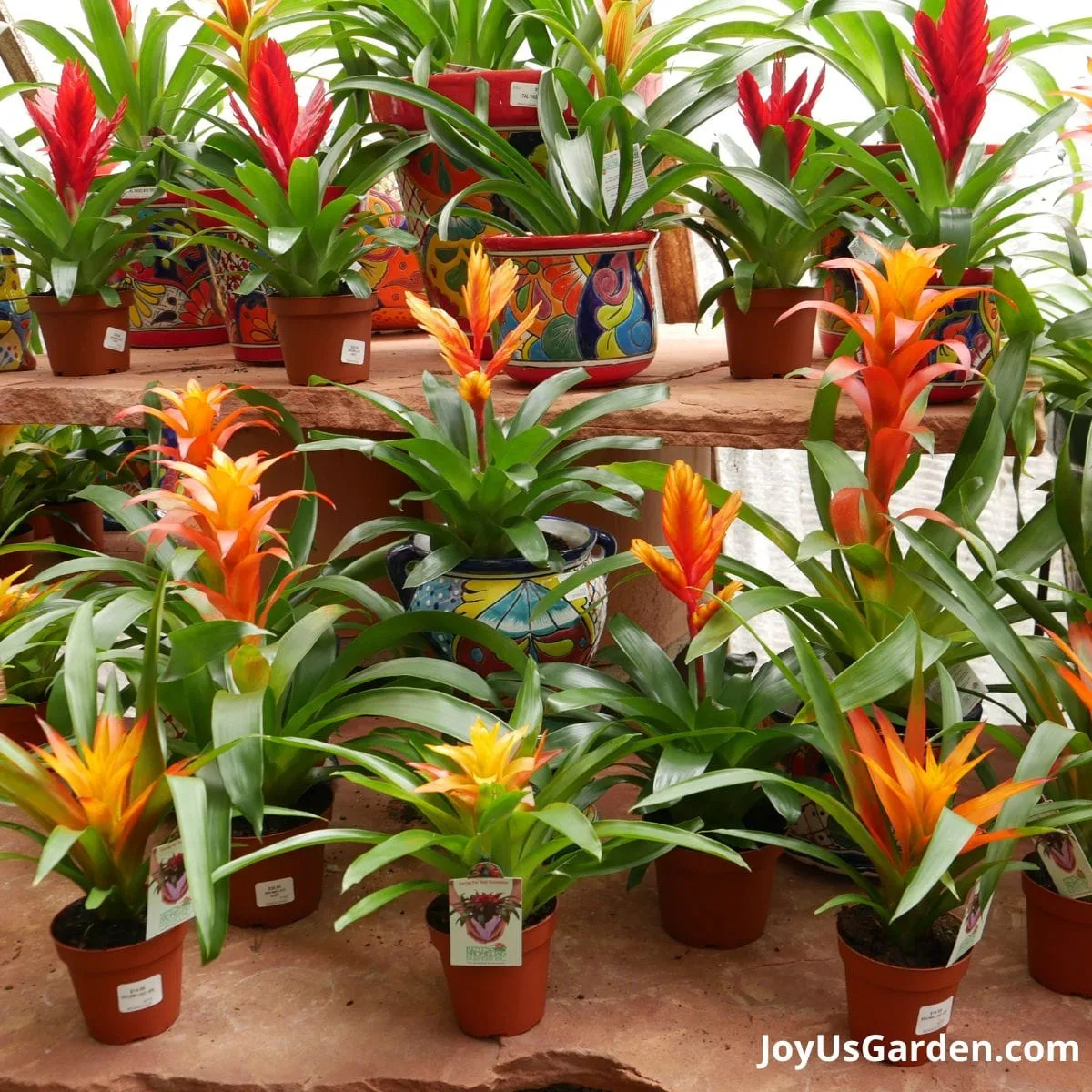
Interested in more on watering this plant? We have a Guide To Watering Bromeliads, which you’ll find helpful.
Humidity / Temperature
As I say about all houseplants: if your house is comfortable temperature-wise for you, then your guzmanias will do just fine. You want to avoid putting it in any areas with cold or hot drafts.
Bromeliads are native to the subtropics and the tropics (locations with high humidity) but seem to handle the lack of humidity in our homes and offices just fine. I want to tell you that Guzmanias are susceptible to brown tipping (at the ends of the leaves), which I point out in the video below.
Fertilizing A Guzmania Plant
Guzmanias, like other bromeliads, get their nutrients from matter which falls on them from plants growing above. The roots are to anchor them onto whatever they’re growing on – trees, rocks, etc. For this reason, it’s best to spray the fertilizer onto the foliage and the growing medium’s surface.
I’ve never fertilized my bromeliads because I found they never really needed it. If your Guzmania does, use an all-purpose orchid food, diluted to 1/2 strength, or a bromeliad fertilizer. Just be sure not to get too much in the tank because the salts in the fertilizer build up and cause burn.
Only feed in the spring or summer, once or twice a year.
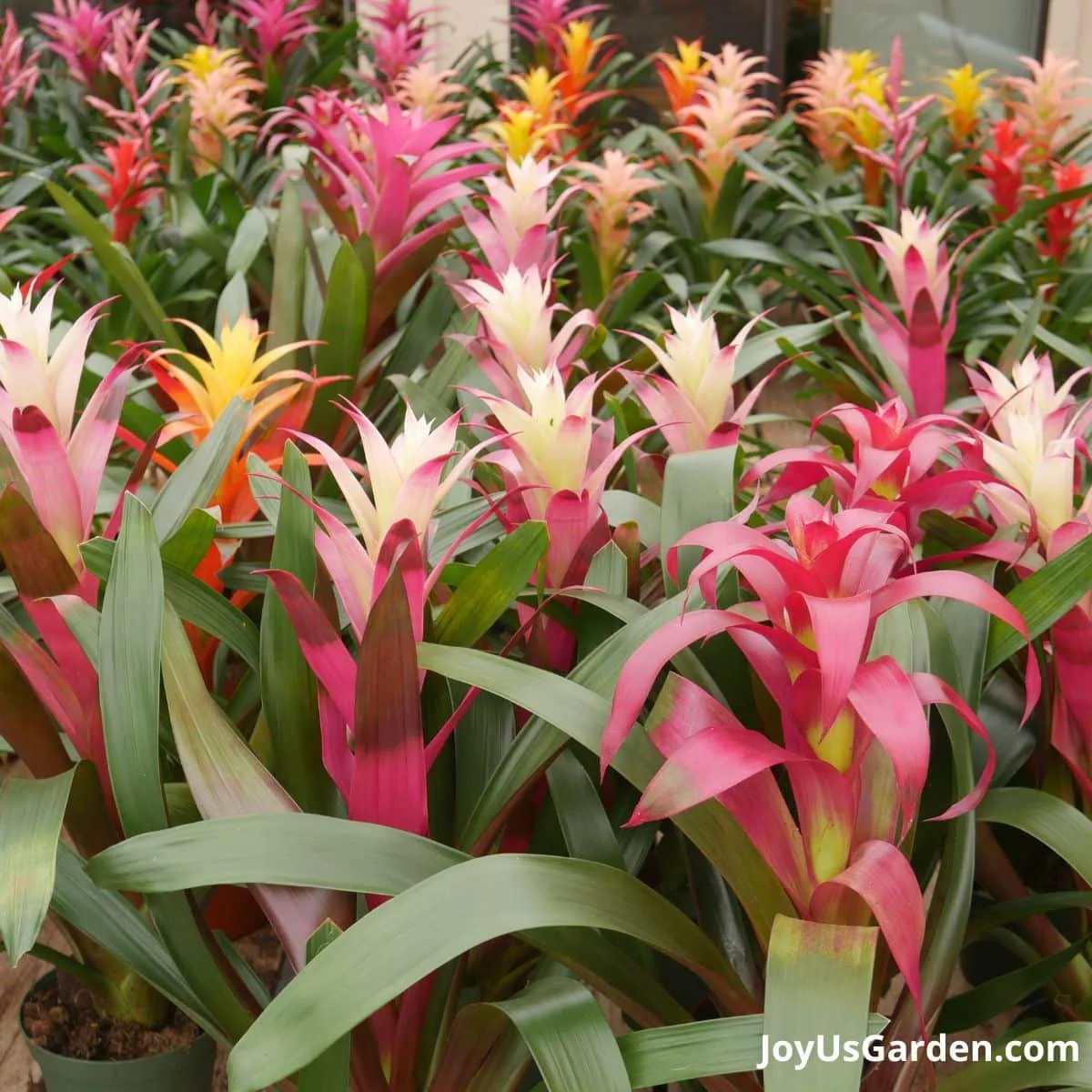
Guzmania Soil
Guzmanias are epiphytes, so their potting mix needs to drain very well. They’ll grow fine in orchid bark or an orchid potting mix. I’ve also used 1/2 orchid bark and 1/2 coco coir, a more sustainable replacement for peat moss.
Repotting
Guzmania bromeliads have small root systems, so yours likely won’t need repotting. If you need to, spring, summer, and early fall are the best times.
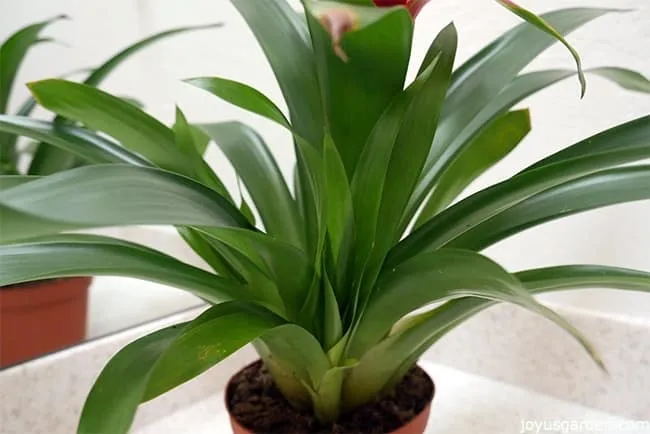
Guzmania Bromeliad Propagation
The mother plant eventually dies (sad but true) after flowering, which is part of their life cycle. Pups or babies (new plants) will appear at the mother’s base, so a part of her lives on. Happy ending!
You can leave the bromeliad pups attached to the mother and cut away the flower and foliage after they die. Or, you can carefully remove the pups with a sharp, clean knife and pot them in fresh mix. They can also be attached to wood, bark, or driftwood for a different look.
If you want more info on bromeliad pups and propagating, here’s a post dedicated to Bromeliad Propagation.
Safe For Pets
Are guzmanias toxic to cats and dogs? According to the ASPCA, guzmania plants are considered non-toxic for cats and dogs.
A word of warning: their leaves are nice and crunchy, so if your kitty likes to munch away, you might want to keep the plant out of reach. It won’t poison but could make Fluffy sick.
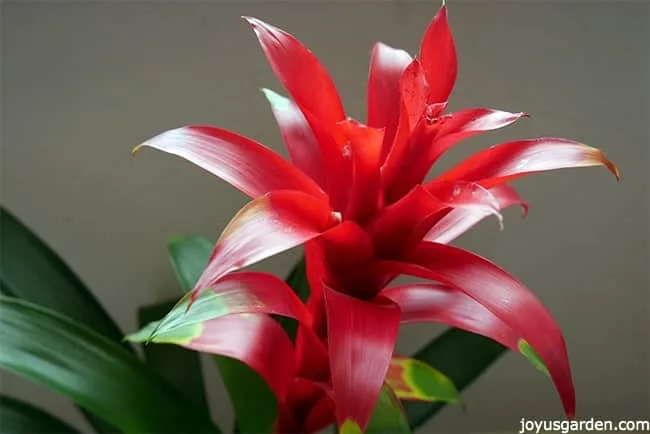
Guzmania Flowers
The colorful bracts provide the wow factor. The small flowers are whitish and fairly inconspicuous. You have to look inside the colorful flower head to see them. Speaking of the colorful flower head, it should last and look good for up to 4 months.
When I’m buying a guzmania, I look inside to make sure the white flowers aren’t open or are just opening. If the flowers are fully open, yours won’t last as long.
A guzmania with a tall flower spike might become top heavy. I’ve had to anchor a couple in their decorative pots to prevent them from tipping over!
Once a guzmania has flowered, the mother plant eventually dies. You can read the highlighted posts below for more details on bromeliad flowers.
Here are some guides you may find helpful on Bromeliad Flowers: How & When to Prune Them Off and Bromeliad Flowers Turning Brown:Why It Happens & What to Do
Guzmania Video Guide
Guzmania Bromeliad FAQs
It depends on the environment your guzmania is growing in. You want to keep the central cup of the plant (aka tank, vase, urn) about 1/4 of the way filled with water. The potting medium can be watered every month or 2. Bromeliads appreciate moisture on their leaves. You can mist your plant once or twice a week.
It takes a bromeliad 3-6 years to flower. After flowering, the plant eventually dies. So, I’d estimate the lifespan to be anywhere from four years to seven years. If you buy a guzmania in flower, it could last four months to nine months.
It doesn’t die immediately when the flower stalk starts turning brown; it’s a slow process. But don’t worry, pups appear at the base, and the mother plant lives on. You can either leave them on or transplant them if you wish.
You cut it off. This post on Bromeliad Flowers explains it further.
They bloom with age, starting at the three or four-year mark on. If your plant isn’t getting enough light, it won’t flower. They need bright indirect light to flower.
Most bromeliads are epiphytes, meaning they grow on rocks and other plants, not in soil. Too much water can lead to diseases. Make sure your plant has sufficient air circulation, the pot has drainage holes, the mix drains well, and it drys out before watering again.
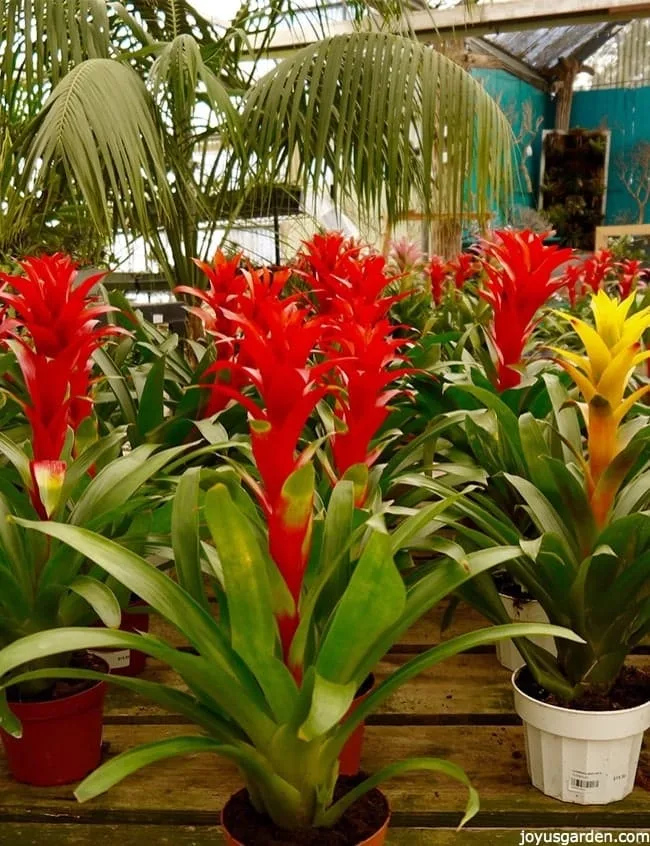
A guzmania bromeliad makes a great houseplant and is super easy to maintain. Remember to provide the right amount of light and water it properly. So go ahead, bring some tropical vibes into your life with a colorful guzmania!
Happy gardening & thanks for stopping by,


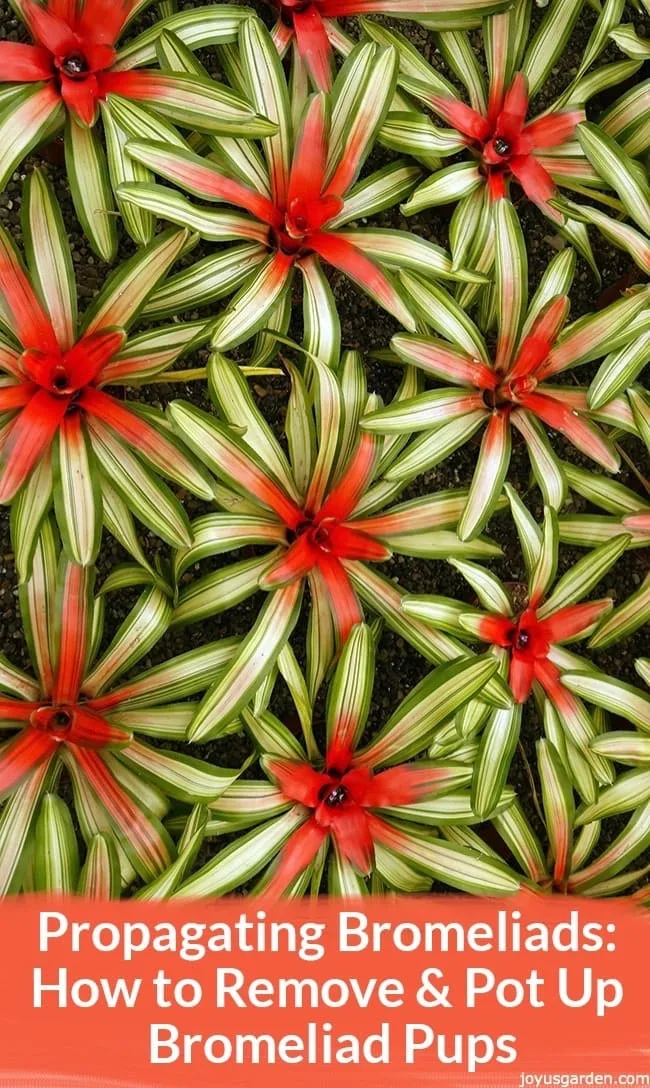
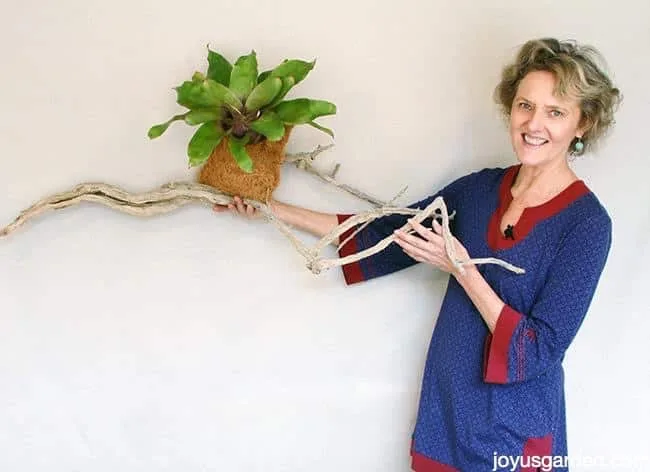
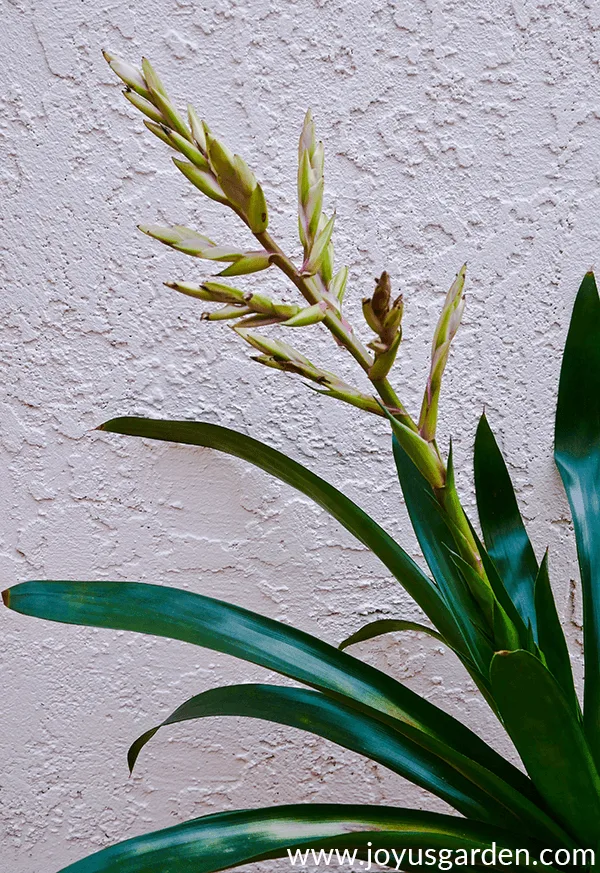
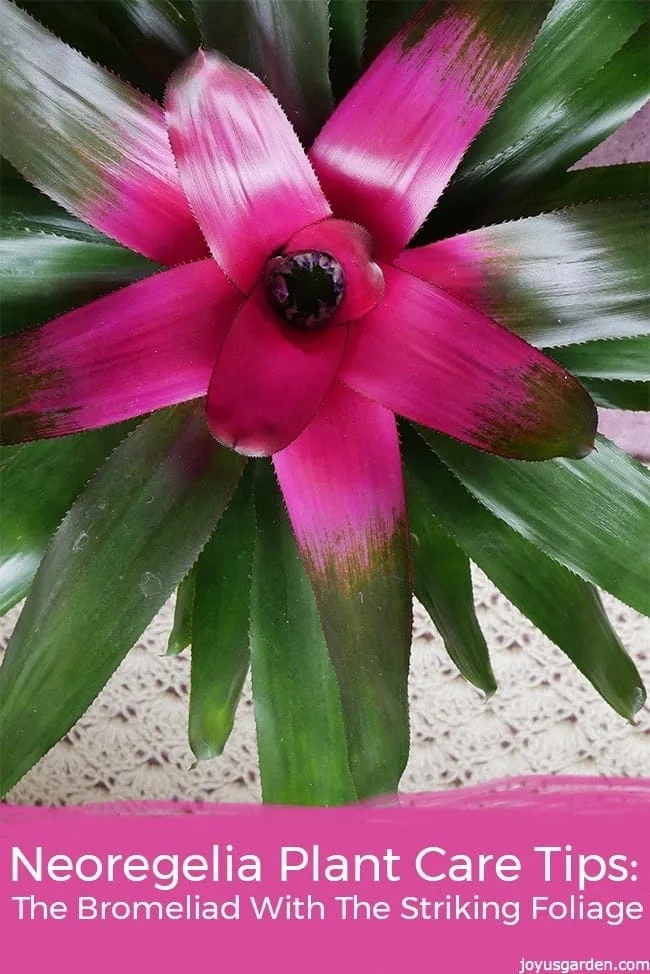
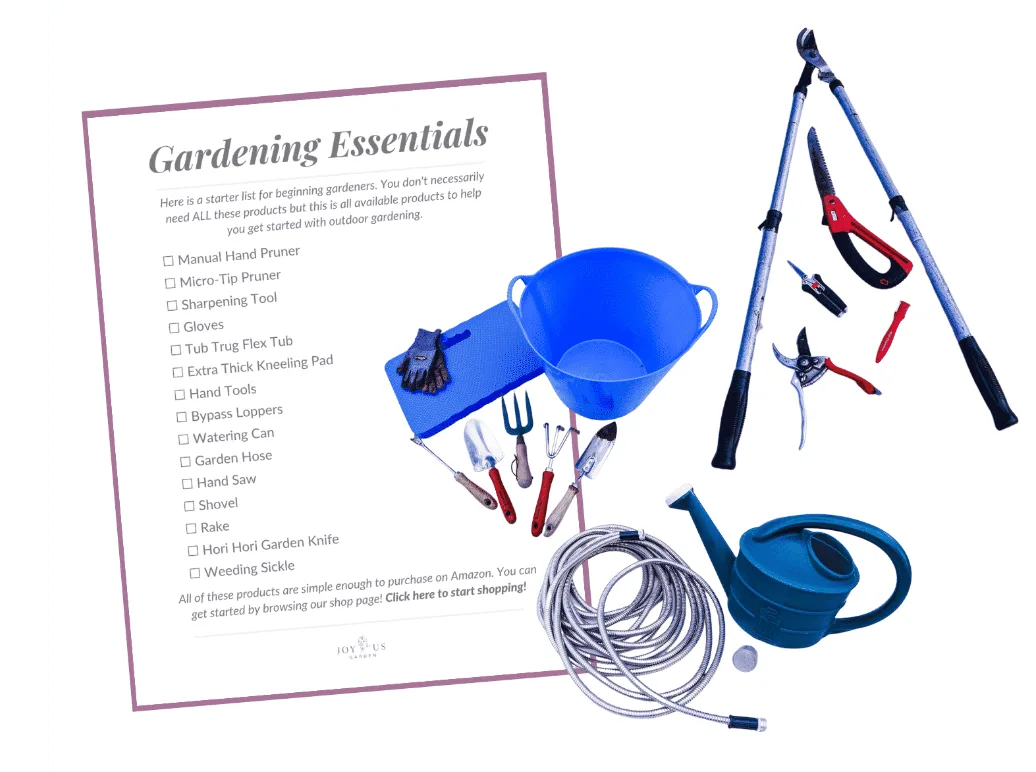
How about if the leaves are curled inward? What should I to about it? When I repotted them I found out the roots got some kind of white tiny eggs, I removed them but what should I do further? Thanks
Hi Liz – When bromeliad leaves curl inward, it’s usually a sigh the plant is too dry. The eggs could be root aphids or root mealy bug. They’re treated in different ways so you can do some research to see if it’s either of those. Nell
I bought my first guzmania but didn’t realize I should mist the leaves plus I had it setting in the front window which doesn’t get a lot of light, but the tips of my red flowering stalk have some brown now. Do I leave the brown tips to die and fall off? What else can I do to “save” it? How far from the window can it be set and still get enough light? As you can tell, I don’t know a lot about plants, but I loved this particular one when I saw it and had to get it. Thanks for your help.
Hi Suzi – There could be a few reasons – here are the 2 most likely. The air is too dry & it’s a reaction to that. More likely: the flower is going through its cycle of dying. Mine is doing that too now. It slowly turns brown. Guzmanias like bright (not direct) natural light but will do fine for a couple of months in lower light. Hope that helps, Nell
Hi Nell
I’ve bought a Guzmania a few weeks ago. Some of the red foliage is turning green on the tips. Is this normal? My plant is not sitting in direct sunlight but I also notice it’s leaning towards the light but as my living room can have quite a bit of sunlight coming through I do not want to put it near to the window. As you can gather I’m new to this and don’t want to lose this plant still learning.
Many thanks
Fiona
Hi Fiona – That is normal. I have a very tall yellow Guzmania sitting right across from me in my office which I’ve had for almost 2 months & the tips of the lower leaves on the flower stalk are turning green. They get less pronounced up near the top of the flower. Nell
Hi Nell
I received the red Guzmania as a host gift and enjoyed this low maintenance plant.
I have my plant outside and it has done very well but now I have about 6 pups. Could you explain
how to cut pups and put on drift wood.
Hi Pat – Sure thing. Here’s how to remove bromeliad pups: https://www.joyusgarden.com/propagating-bromeliads-how-to-remove-pot-up-bromeliad-pups/
And here’s 1 way to attach them to driftwood: https://www.joyusgarden.com/easy-way-grow-bromeliads-driftwood-branch/ Here are some other methods: https://www.joyusgarden.com/succulents-driftwood/ You could easy wrap them in moss & attach them. Nell
The heart of the blossom (red leaves) are turning brown. Is that the dying process or something I am doing wrong?
Hi Teresa – Its most likely dying. Here’s a post & video I did about that: https://www.joyusgarden.com/bromeliad-flowers-turning-brown-why-it-happens-what-to-do-about-it/ Nell
So I bought a smaller one of these. Will it get bigger and long will it live for?
Hi Melinda – Your mother plant will start to die after it flowers; so no. However, pups (babies) will form off the mother plant & they’ll grow & get bigger. If you want a large plant, buy one at the size you want it. Nell
HI NELL!
YOU ROCK! GREAT SITES!
Well thank you Tracy! Much appreciated!! Nell
The flower turned all green. Should after that be cut off or left alone?
Sherie – Either way. This will help: https://www.joyusgarden.com/bromeliad-flowers-turning-brown/ Nell
Hi,
I think I have been putting to much water in the cup of my bromeliad. She is rooting. can I save her?
Nina – Unless you live in a hot climate, I advise keeping the cup 1/4 at the very most. I assume you mean rotting & not rooting. Pour the water out of the cup (if any still remains in there) & see if it recovers. When a plant starts to rot, it’s oftentimes hard to save it. Nell
Thanks so much Nell!
A friend had bought this as a moving in present (from a stardard shop so it had no name tag) we were so new to houseplants that we had it in our conservatory ? the ‘flower’ died and I did just cut it away which I’m glad to read was OK and have got 6 pups from it, I figured it would just be a mother plant now so good to know it will die completely (saves me keeping it once it’s stopped birthing) ?? thanks for the great tips ?
You’re welcome Lydia! They do die after flowering but the happy news is, they produce pups. Just as you found out! Nell
Good thing I came across this post! I ordered some guzmanias from an online shop not really knowing what they were – we are still under lockdown in my small equatorial nation and plants have been my outlet. I repotted into regular potting mix because the roots looked so cramped in the coco fibre medium and growing pots they came in. Sounds like they are now at risk for rot, especially since it’s quite humid down here! Would you advise replanting in additional coco fibre, or just removing the additional soil I put them in and returnign to the original “footprint” and medium of the plant (especially since I didn’t pull away any of the fibre)?
JJ – I plant my bromeliads in 1/2 potting soil & 1/2 orchid bark. This has worked well for me over the years. You may find this helpful: https://www.joyusgarden.com/bromeliads-101/ Nell
Great video and information, I received a Guzmania as a gift in May and it was flowering when I recieved it, the flower has recently died off now and I have 3 or 4 “pups” and the mom plant is starting to die back.
So I’m glad to find your video and info and know that is the natural cycle and I can replant my pups and hopefully one day get flowers from them.
Thank you Gwen! Just remember, it can take up to 5 years for a pup to bloom. Enjoy,
Nell